Miss O’Connor at 100
On this her 100th birthday, join me on a meditative tour of Flannery O'Connor's Andalusia and environs
You received this email because you subscribed to THE COMIC MUSE, the newsletter of author and philosopher Daniel McInerny.
Art as a picturing of “the action that actualizes or destroys our beatitude.” That is the business of THE COMIC MUSE.
I’m so glad you’re here.
If you’re visiting for the first time…
Today, Tuesday, March 25, 2025, marks the 100th birthday of one of the greatest writers of the 20th century: Flannery O’Connor (1925-1964). As O’Connor was a devout Catholic, how lovely that this anniversary dovetails with the Solemnity of the Annunciation of the Lord.
I didn’t even realize it when I designed my syllabus back in January, but today in my philosophy elective, Poetic Experience & Truth, we are set to discuss O’Connor’s short story, “Good Country People,” in conjunction with her essay from Mystery & Manners, “Writing Short Stories.” A nice way to celebrate her birthday!
Inside the visitors center at O’Connor’s former home, Andalusia
Georgia College & State University (O’Connor’s alma mater) administers Andalusia now as a historical site. But it once was the dairy farm that O’Connor’s mother, Regina, owned and ran, and at which O’Connor lived for the last 13 years of her all-too-brief life before she succumbed to lupus.
I visited Andalusia the week before last, on a picture-perfect March afternoon.
The site is located outside the town of Milledgeville, in Baldwin County, central Georgia.
“In the spring of 1951, shortly after her twenty-sixth birthday, Flannery and her mother moved to Andalusia, a practical change motivated by her difficulty navigating steps at the Cline Mansion [the home of a relative in downtown Milledgeville], and allowing more privacy for recovering and writing. Regina O’Connor had already been spending more time at the dairy farm, as she became that most daunting of figures in a small Southern town, a tough businesswoman. After a summer marked by several returns to the Atlanta hospital, Flannery filled in the Fitzgeralds [Robert & Sally] on her situation: “Me and maw are still at the farm and are like to be, I perceive, through the winter. She is nuts about it out here, surrounded by the lowing herd and other details, and considers it beneficial to my health. The same has improved.”
—Flannery: A Life of Flannery O’Connor by Brad Gooch, 195.
“Greetings from historic Milledgeville where the ladies and gents wash in separate tubs.”
—Flannery O’Connor, Letter to Maryat Lee, 19 May, 1957
*** Quotations from O’Connor’s letters are taken from the collection of her letters entitled The Habit of Being, selected and edited by Sally Fitzgerald
Milledgeville is certainly more built-up than when O’Connor lived there. The video below shows the Andalusia visitors center in the background and the busy four-lane highway that now abuts the property.
It’s just about a quarter mile from the visitors center to the O’Connor farm house. Join me as I make the walk…
The O’Connor farm house.
I don’t think there was a cloud in the sky all day.
“As Regina busied herself with driving about the property in her stick-shift automobile, inspecting fencing, or planning a livestock pond at the bottom of the hill, her daughter stayed in her room, shades drawn, having reinstated an inviolable regimen of writing for several hours in the morning.”
—Flannery: A Life of Flannery O’Connor by Brad Gooch, 197-98.
Here is a video of the first-floor room where O’Connor, because of her debilitating illness, both slept and worked…
“I’m a full-time believer in writing habits, pedestrian as it all may sound. You may be able to do without them if you have genius but most of us only have talent and this is simply something that has to be assisted all the time by physical and mental habits or it dries up and blows away. I see it happen all the time. Of course you have to make your habits in this conform to what you can do. I write only about two hours every day because that’s all the energy I have, but I don’t let anything interfere with those two hours, at the same time and the same place. This doesn’t mean that I produce much out of the two hours. Sometimes I work for months and have to throw everything away, but I don’t think of any of that was time wasted. Something goes on that makes it easier when it does come well. And the fact is if you don’t sit there every day, the day it would come well, you won’t be sitting there.”
—Flannery O’Connor, Letter to Cecil Dawkins, 22 September 1957
“Naw you didn’t say the artist is above the common people, that was just my digression on the subject, but you do seem to exalt him above his place in the scheme of things though it is hard to put my finger on just how. The word “dreams” which you did use, always terrifies me. The artist dreams no dreams. That is precisely what he does not do, as you very well know. Every dream is an obstruction to his work. I have sent you Art and Scholasticism [a 1920 book by the French Catholic philosopher, Jacques Maritain.] It’s the book I cut my aesthetic teeth on, though I think even some of the things he [Maritain] says get soft at times. He is a philosopher and not an artist but he does have great understanding of the nature of art, which he gets from St. Thomas.”
—Flannery O’Connor, Letter to “A” (Betty Hester), 20 April 1957
In working with O’Connor’s archives at Georgia College & State University, I was allowed the privilege of perusing O’Connor’s personal copy of Art & Scholasticism. O’Connor didn’t write in her books, I was surprised to learn, but she underlined more passages and bracketed more paragraphs in Art & Scholasticism than any other book of hers I looked at.
“I am always vastly irritated by these people (I guess like [Wallace] Stegner) who know as much about the South as I do about lower Hoboken and on the strength of it advise Southern writers to leave it and forget the myth. Which myth? If you’re a writer and the South is what you know, then it’s what you’ll write about and how you judge it will depend on how you judge yourself. It’s perhaps good and necessary to get away from it physically for a while, but this is by no means to escape it. I stayed away from the time I was 20 until I was 25 with the notion that the life of my writing depended on my staying away. I would certainly have persisted in that delusion had I not got very ill and had to come home. The best of my writing has been done here.”
—Flannery O’Connor, Letter to Cecil Dawkins, 16 July 1957
Looking at this kitchen, you can almost hear the Mrs. Freeman and Mrs. Hopewell of “Good Country People” having their morning conversation. O’Connor bought that fridge for her mother from the proceeds of selling her short story, “The Life You Save May Be Your Own” to television. The resulting show appeared on the Schlitz Playhouse of Stars (!) on March 1, 1957, and starred Gene Kelly, of all people. O’Connor was appalled by the casting and mortified by the show, but delighted by the fridge.
I do not have any personal connection to O’Connor, unless you want to count the fact that she died exactly one week after I was born (O’Connor died on August 3, 1964). On second thought, there is one somewhat tenuous, but much cherished connection. She was good friends with Thomas Stritch, a professor of American Studies at the University of Notre Dame and a dear friend of my parents (my father, Ralph McInerny, 1929-2010, taught philosophy at Notre Dame for over 50 years). I can still see “Tom Stritch,” as my mother called him, a diminutive man with a basso profundo Southern voice, greeting my father with the familiar salutation, “My dear fellow!” and sitting in my parents’ living room in South Bend, Indiana. I’m not sure, when seated, if his feet quite hit the floor. I remember helping my mother clear out his overstuffed South Bend house when he retired and readied to return to his native Nashville. Some time in the late 1990s, while at an academic conference in Nashville, I visited Tom Stritch in the hospital where he was recuperating. He was still as hilarious as ever. I suspect he was O’Connor’s host when she gave a talk at Notre Dame in 1957. Tom Stritch died in 2004 at the age of 91, 40 years after his friend Flannery O’Connor’s death.
Speaking of hilarious. Here is O’Connor’s report to Tom Stritch about a rare writers conference she attended, which seemed to consist almost entirely of old ladies:
“I was one of the lesser features. The big attractions were the New York Agent Who Sold Gone with the Wind to the Movies, and two giant-sized poetesses from South Georgia who conducted a panel on “The Religious Market.” One old sister said she wrote true-confession stories with one hand and Sunday-school stories with the other—which sounds right to me as I always suspected the same mind produced both. There was one bright spot in all this: an old man (the only man) from Louvail, Ga., who attended every session and broke up every one that he attended. He quoted extensively from Dickens and the Bible and held the floor with a terrible tenacity. He hated the old ladies and they hated him.”
—Flannery O’Connor, Letter to Thomas Stritch, 1 August, 1957
Flannery O’Connor’s writing desk. Note the statuette of Our Lady and the small bottle of holy water. Plus the fact that the desk and typewriter face away from the window behind her chair, where she might have been distracted by the pleasant view of the yard and hill running down to the cow pond.
Books on display in O’Connor’s room. Including a part of the Roman Breviary and a “greatest hits” volume of St. Thomas Aquinas…
No other top-drawer 20th-century writer was more inspired by Aquinas than Flannery O’Connor, with the one exception of James Joyce. The different ways in which they took that inspiration will be a theme of my next book on the philosophy of art.
Also like Joyce, O’Connor was inspired by keeping up with the local papers…
“What she could not discover by direct observation, she picked up by reading, closely, the weekly Union-Recorder, along with Georgia’s agricultural tabloid, the Farmer’s Market Bulletin; she later told a friend that she “gleaned many a character” from its pages. The previous September, the newspaper ran an article, “Want to Win Movie Pass? Shake Hands with Live Gorilla,'“ on the appearance at the Campus Theatre of Congo, the star of Mark of the Gorilla, in time for her to swipe its handshaking stunt, and the phrase “first ten brave enough,” for Wise Blood. In August 1951, the paper featured the 106-year-old Confederate veteran General William J. Bush, photographed in a “dashing” full-dress uniform and military hat, attending the graduation of his 62-year-old wife from GSCW [Georgia State College for Women, as O’Connor’s alma mater was then called]. O’Connor lifted and doctored the item when she returned to story writing the following summer, in “A Late Encounter with the Enemy.”
—Flannery: A Life of Flannery O’Connor by Brad Gooch, 202
The famous front steps to the farm house at Andalusia, once ascended by the likes of Caroline Gordon, Robert Giroux, Katherine Anne Porter, and many others.
Here I am at the back of the house, taking a look around while waiting for my tour to begin…
It is well-known that Flannery O’Connor loved peafowl (peacocks) and raised them at Andalusia, often to the consternation of her mother. The peacock feather is used as a sign for O’Connor all around Milledgeville.
“It is not known by everybody but: the peafowl is called peafowl because his favorite dish is peas—green peas, black-eyed peas, sweets or any peas that come to mind. Furthermore, the peacock sheds his tail every August and the alert owner goes behind with a bucket and picks up each feather.”
—Flannery O’Connor, Letter to Maryat Lee, 4 April 1957
A view of the house from the far side of the cow pond.
O’Connor’s room, where she did all her best writing, is on the ground floor left as you look at the house from this perspective.
As I toured the house and walked the grounds of the farm, T.S. Eliot’s lines from “Little Gidding” kept going through my head:
You are not here to verify,
Instruct yourself, or inform curiosity
Or carry report. You are here to kneel
Where prayer has been made valid.
The room in particular where O’Connor wrote and suffered her illness seems to me to be a place “Where prayer has been made valid.” And so I took it as a high duty that day not just to “inform curiosity” or “carry report,” but “kneel” in the sense of praying for the repose of O’Connor’s soul and for those of her family members.
Sacred Heart Catholic Church in Milledgeville, where O’Connor and her mother were daily communicants.
I had hoped to end my visit with Mass at Sacred Heart, but for some reason the priest was away. But it was a Friday and the Blessed Sacrament was exposed, and I had the opportunity of joining the locals for the Rosary.
“I have been right weak since my dose was cut in half but now we are going back to smaller doses 4 times a day so I hope for some increase in energy. Yesterday the priest brought me Communion as it looks like a long time before I’m afoot. I also had him give me the now-called Sacrament of the Sick. Once known as Extreme Unction.”
—Flannery O’Connor, Letter to Janet McKane, 8 July 1964
Flannery O’Connor’s grave at Memory Hill Cemetery in Milledgeville, a short walk from Sacred Heart Catholic Church
My novel, The Good Death of Kate Montclair, is available here.
Read the first chapter here.

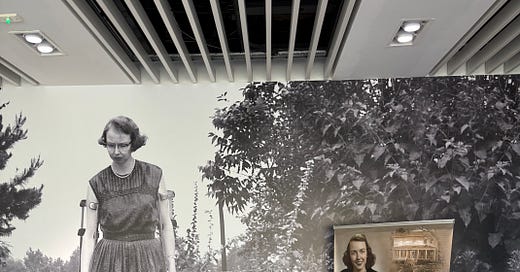




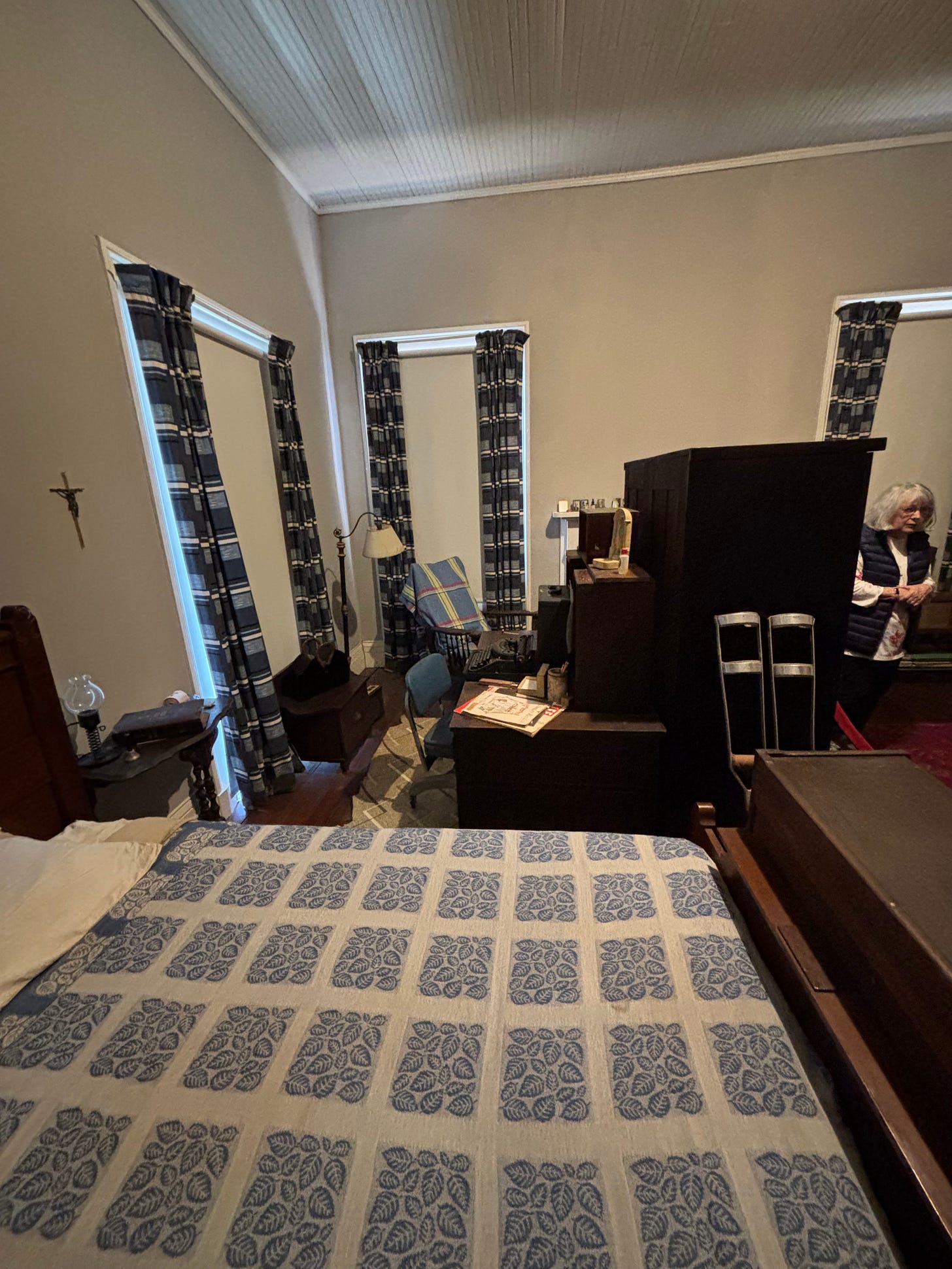


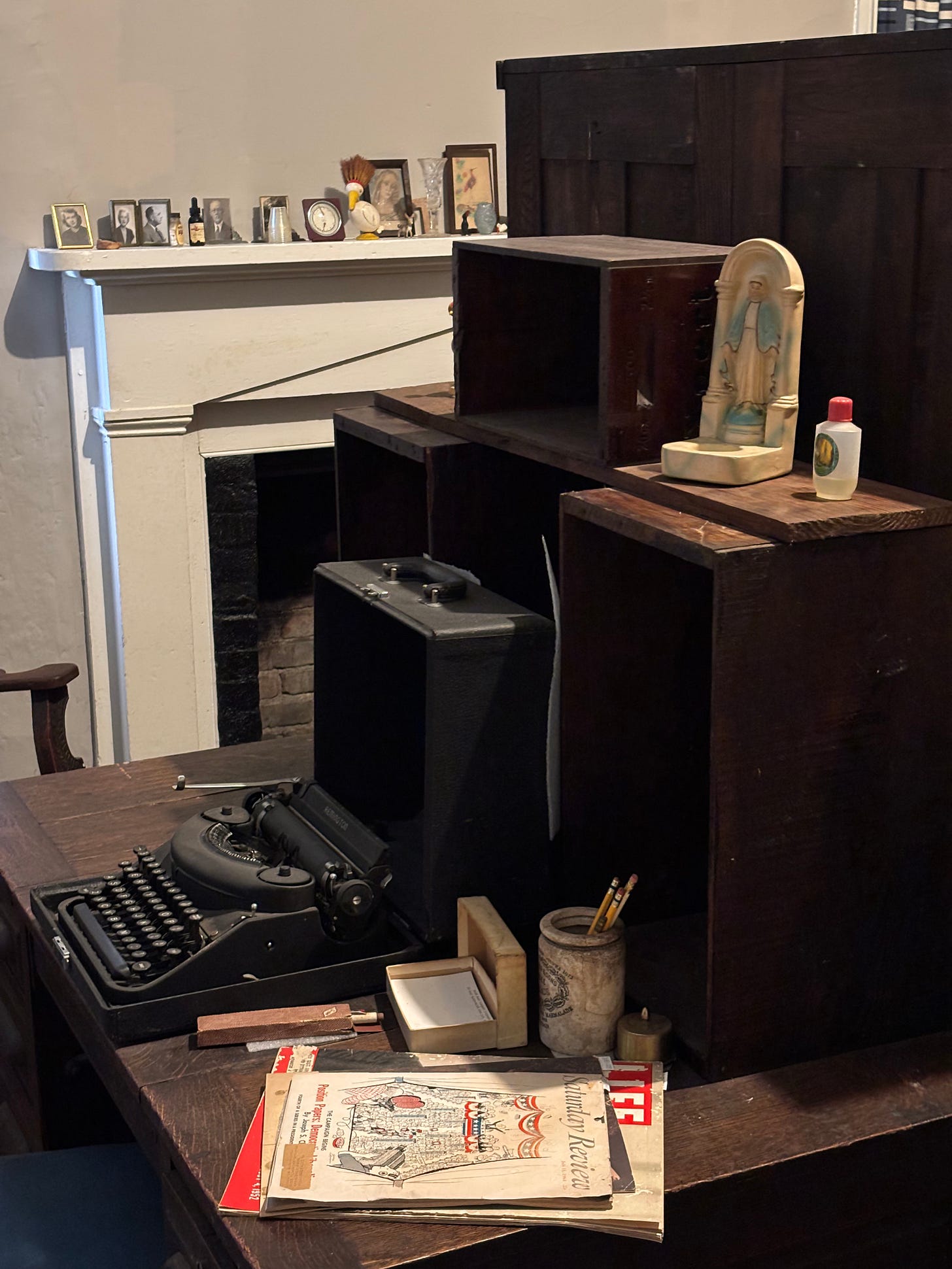


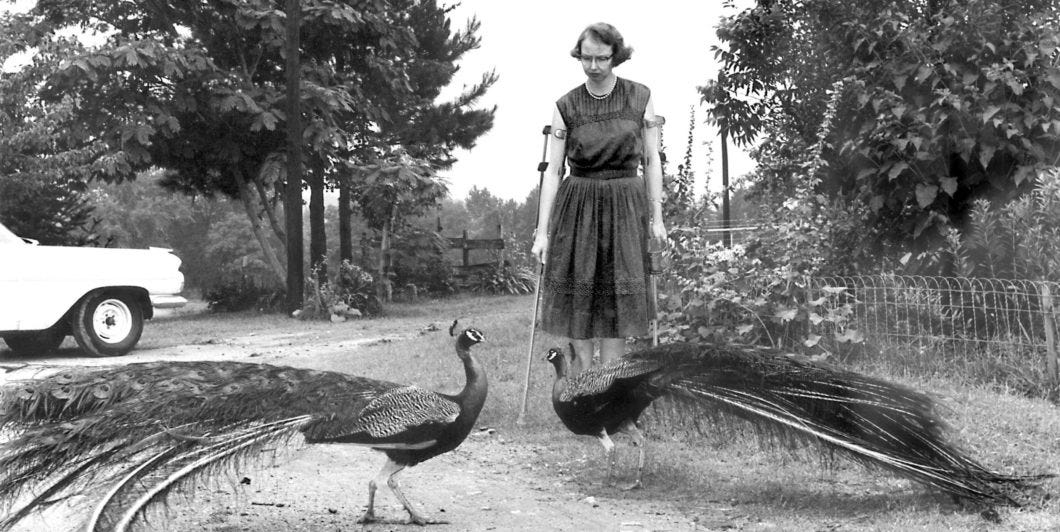




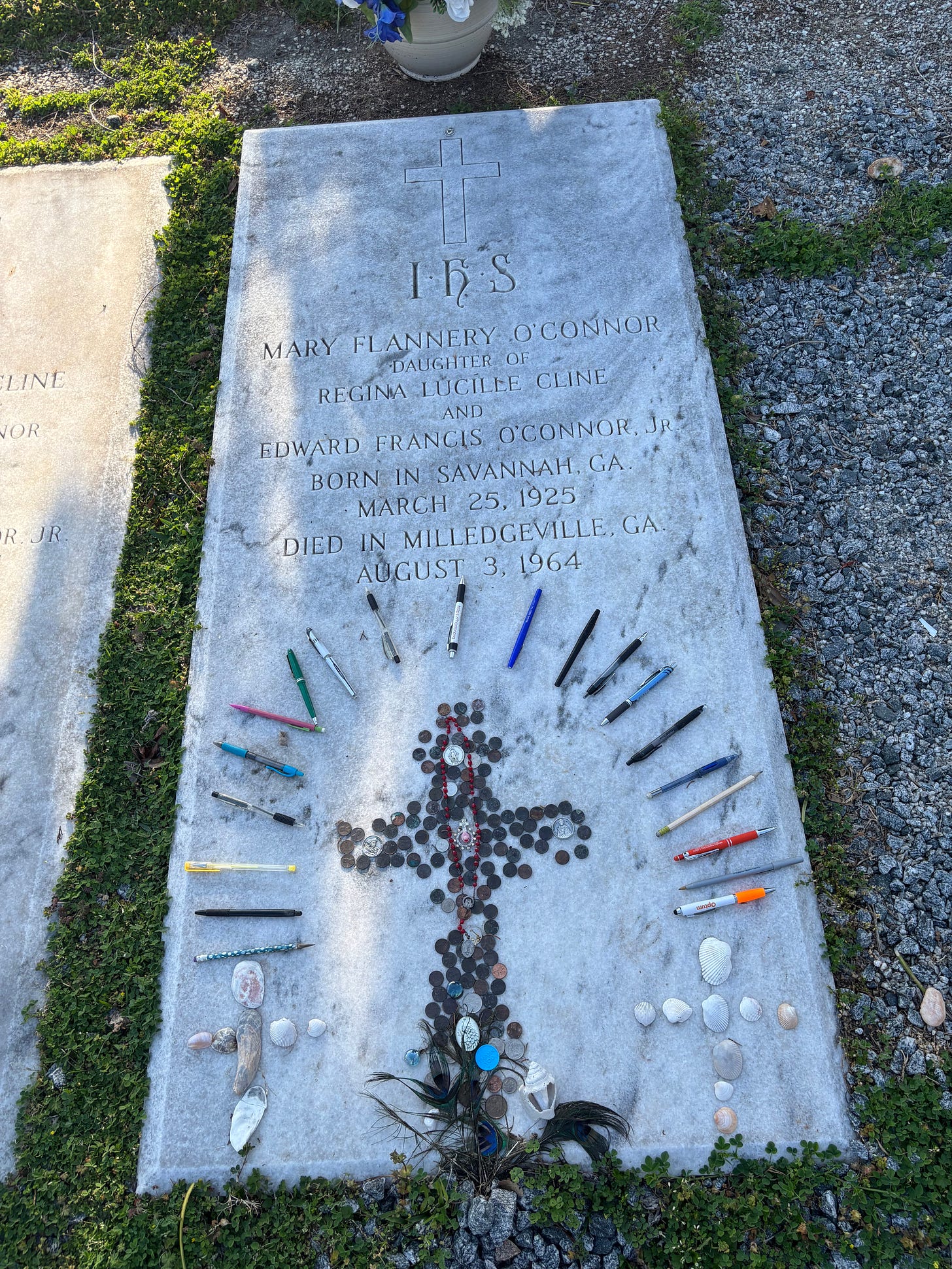
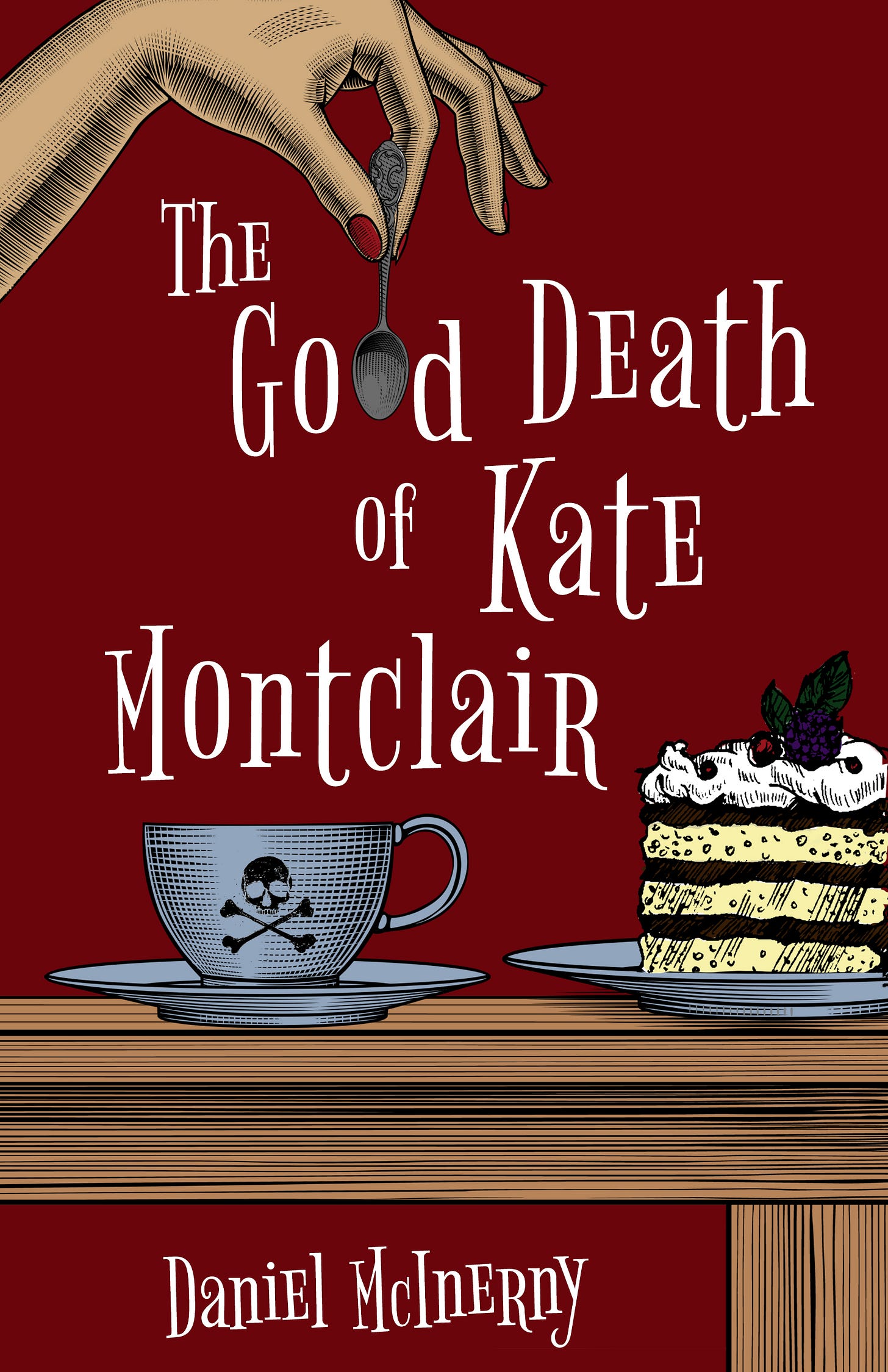
Oh, this is a great visit and article! Flannery is one of my favorite authors to read and teach. Her voice and her insistence are unmatched as a Catholic Southern woman. Lovely post and a tribute to her.
Lovely tour! Living in Georgia all my life, I finally went to Andalusia last March with my family and posted about it for her 99th birthday. I too visited all these spots in Milledgeville. The fact that the house is largely the same, with most of the original furnishings and other belongings, is a real treat. And I was born on the exact date of O'Connor's death, fifteen years later!